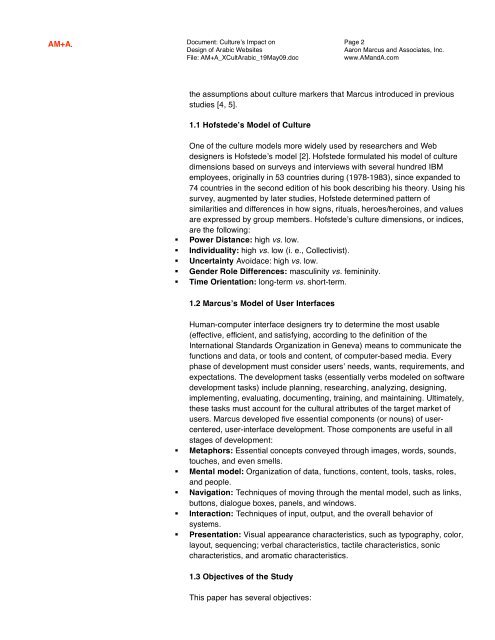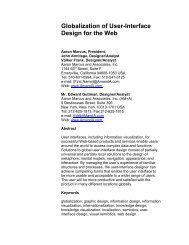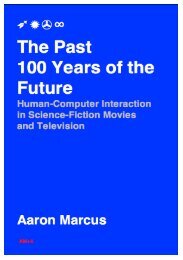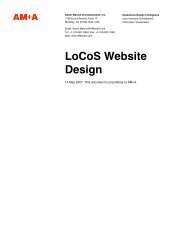Culture's Impact on Arabic Website Design - Aaron Marcus and ...
Culture's Impact on Arabic Website Design - Aaron Marcus and ...
Culture's Impact on Arabic Website Design - Aaron Marcus and ...
Create successful ePaper yourself
Turn your PDF publications into a flip-book with our unique Google optimized e-Paper software.
AM+A.Document: Culture’s <str<strong>on</strong>g>Impact</str<strong>on</strong>g> <strong>on</strong><strong>Design</strong> of <strong>Arabic</strong> <strong>Website</strong>sFile: AM+A_XCult<strong>Arabic</strong>_19May09.docPage 2Aar<strong>on</strong> <strong>Marcus</strong> <strong>and</strong> Associates, Inc.www.AM<strong>and</strong>A.comthe assumpti<strong>on</strong>s about culture markers that <strong>Marcus</strong> introduced in previousstudies [4, 5].1.1 Hofstede’s Model of CultureOne of the culture models more widely used by researchers <strong>and</strong> Webdesigners is Hofstede’s model [2]. Hofstede formulated his model of culturedimensi<strong>on</strong>s based <strong>on</strong> surveys <strong>and</strong> interviews with several hundred IBMemployees, originally in 53 countries during (1978-1983), since exp<strong>and</strong>ed to74 countries in the sec<strong>on</strong>d editi<strong>on</strong> of his book describing his theory. Using hissurvey, augmented by later studies, Hofstede determined pattern ofsimilarities <strong>and</strong> differences in how signs, rituals, heroes/heroines, <strong>and</strong> valuesare expressed by group members. Hofstede’s culture dimensi<strong>on</strong>s, or indices,are the following:Power Distance: high vs. low.Individuality: high vs. low (i. e., Collectivist).Uncertainty Avoidace: high vs. low.Gender Role Differences: masculinity vs. femininity.Time Orientati<strong>on</strong>: l<strong>on</strong>g-term vs. short-term.1.2 <strong>Marcus</strong>’s Model of User InterfacesHuman-computer interface designers try to determine the most usable(effective, efficient, <strong>and</strong> satisfying, according to the definiti<strong>on</strong> of theInternati<strong>on</strong>al St<strong>and</strong>ards Organizati<strong>on</strong> in Geneva) means to communicate thefuncti<strong>on</strong>s <strong>and</strong> data, or tools <strong>and</strong> c<strong>on</strong>tent, of computer-based media. Everyphase of development must c<strong>on</strong>sider users’ needs, wants, requirements, <strong>and</strong>expectati<strong>on</strong>s. The development tasks (essentially verbs modeled <strong>on</strong> softwaredevelopment tasks) include planning, researching, analyzing, designing,implementing, evaluating, documenting, training, <strong>and</strong> maintaining. Ultimately,these tasks must account for the cultural attributes of the target market ofusers. <strong>Marcus</strong> developed five essential comp<strong>on</strong>ents (or nouns) of usercentered,user-interface development. Those comp<strong>on</strong>ents are useful in allstages of development:Metaphors: Essential c<strong>on</strong>cepts c<strong>on</strong>veyed through images, words, sounds,touches, <strong>and</strong> even smells.Mental model: Organizati<strong>on</strong> of data, functi<strong>on</strong>s, c<strong>on</strong>tent, tools, tasks, roles,<strong>and</strong> people.Navigati<strong>on</strong>: Techniques of moving through the mental model, such as links,butt<strong>on</strong>s, dialogue boxes, panels, <strong>and</strong> windows.Interacti<strong>on</strong>: Techniques of input, output, <strong>and</strong> the overall behavior ofsystems.Presentati<strong>on</strong>: Visual appearance characteristics, such as typography, color,layout, sequencing; verbal characteristics, tactile characteristics, s<strong>on</strong>iccharacteristics, <strong>and</strong> aromatic characteristics.1.3 Objectives of the StudyThis paper has several objectives:






